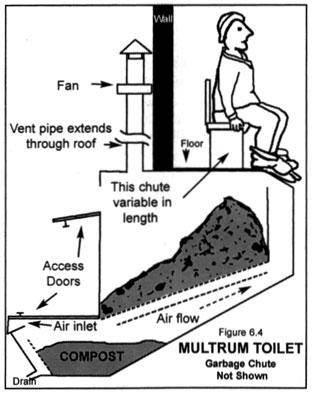












-Nathanael








From a conventional flush toilet, flushings drain through a waste pipe into an insulated plastic container. The container holds a large quantity of worms who inhabit the surface layers of a mass of carbon-rich organic material (wood shavings, bracken, leaf litter, etc. topped with a starter layer of half-processed compost).
When the flushings enter the container, the solids remain on the surface to be processed by the worms and the liquids drain through the organic filter material and exit the container. They then pass through another waste pipe to a growing bed, also full of carbon-rich material, where they’re taken up by plants or processed by soil bacteria.
I used a second-hand 1,000-litre plastic IBC to form the basis of the system. We made an access hatch by cutting half of the tank’s top out. It slots back into place neatly, held by the screw-top lid to the central opening (through which the waste pipe empties into the tank) and an aluminium bar which clips onto the frame each side. Once the tank was sited, we connected 110mm plastic waste pipe to the outlet and dug it into a trench leading to the growing bed.
-Nathanael
















-Nathanael









![Filename: teepee-cottage-bathroom-36.jpg
Description: [Thumbnail for teepee-cottage-bathroom-36.jpg]](/t/48442/a/30084/teepee-cottage-bathroom-36.jpg)




Jim Gardener wrote:Worms will probably drown in the amount of water a regular toilet drops into a septic tank.








Jim Gardener wrote:I don't want to view your link, as that site has a poor reputation from Web of Trust, but my concern is you need to make sure your biomass drains very quickly, as worms need to breathe and can't if the material is saturated with water.





















|
Can you really tell me that we aren't dealing with suspicious baked goods? And then there is this tiny ad:
The new permaculture playing cards kickstarter is now live!
https://www.kickstarter.com/projects/paulwheaton/garden-cards
|



